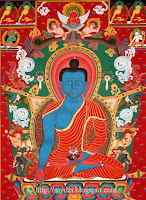 In Mahayana Buddhism there are eight auspicious symbols (sanskrit: Astamangal) or the eight auspicious and glorious emblems. These symbols appear all together (like picture in right) or single as frequent decorative motif in stone, wood, metal and paintings. In this post I like to show you eight auspicious symbols carved in wood.
In Mahayana Buddhism there are eight auspicious symbols (sanskrit: Astamangal) or the eight auspicious and glorious emblems. These symbols appear all together (like picture in right) or single as frequent decorative motif in stone, wood, metal and paintings. In this post I like to show you eight auspicious symbols carved in wood.These symbols are believed to represent the gifts, given by celestial beings to the Shakyamuni Buddha on his attainment of enlightenment of Buddhahood.
 Precious Umbrella
Precious UmbrellaThe precious umbrella symbolizes protection and royalty. The shadow protects from the heat and sun, and the coolness of the shade represents protection or preserving beings from the heat of suffering, obstacles, desire, illness and so forth in this life and all kinds of temporary and enduring sufferings of the three lower realms, and the realms of men and gods in future lives. It also represents the enjoyment of a feast of benefit under its cool shade. The parasol dome can symbolize wisdom and the hanging skirt symbolizes compassion.
 Right-coiled White Conch
Right-coiled White ConchThe white conch which coils to the right symbolizes the deep, far-reaching and melodious sound of the Dharma teachings, which being appropriate to different natures, predispositions and aspirations of disciples, awakens them from the deep slumber of ignorance and urges them to accomplish their own and others' welfare.
 Victory Banner
Victory BannerThe victory banner symbolizes the victory of the activities of one's own and others body, speech and mind over obstacles and negativitities. It was adopted as the symbol of Buddha's enlightenment. It also stands for the complete victory of the Buddhist Doctrine over all harmful and pernicious forces.
 Golden Fish
Golden FishThe golden fish symbolizes happiness the auspiciousness of all living beings in a state of fearlessness, without danger of drowning in the ocean of sufferings, and migrating from place to place freely and spontaneously, just as fish swim freely without fear through water.
 Dharma Wheel
Dharma WheelThe golden wheel symbolizes the auspiciousness of the turning of the precious wheel of Buddha's doctrine, both in its teachings and realizations, in all realms and at all times, enabling beings to experience the joy of wholesome deeds and liberation.
 Endless Knot(The auspicious drawing)
Endless Knot(The auspicious drawing)The Endless Knot symbolizes the mutual dependence of religious doctrine and secular affairs. Similarly, it represents the union of wisdom and method, the inseparability of emptiness and dependent arising at the time of path, and finally, at the time of enlightenment, the complete union of wisdom and great compassion.
Endless Knot is one of the most favorite symbols in Tibetan Buddhism. It is often related to the endless wisdom of Buddha and it is also significant for the interaction of opposing forces leading to their union and harmony in the universe. The symmetrical shape of the knot signifies all these things and arouses the curiosity of those who are passionate about wearing Tibetan jewelry. Giving someone Tibetan gift representing an Endless Knot, it signifies a connection between the giver and the receiver. It is also a reminder that the roots of every future positive effect are found in the present.
 Lotus Flower
Lotus FlowerThe lotus flower symbolizes purity, It is able to grow and blossom from the muddy water, and therefore is a symbol of divine generation. the complete purification of the defilements of the body, speech and mind, and the full blossoming of wholesome deeds in blissful liberation. Deities are often depicted holding a lotus as a symbol of their purity, compassion, renunciation and perfection of qualities.
 Vase of Treasure
Vase of TreasureThe treasure vase or (sanskrit: Kalash) symbolizes an endless rain of long life, wealth and prosperity and all the benefits of this world and liberation.
Eight Auspicious Symbols are usually displayed during the all good ceremonies. i.e.: consecration of house, fire sacrifice, wedding, etc.
Read Meaning in Thai สื่อความหมายของ "อัฐมังคลา" หรือมงคล 8 ประการ

















